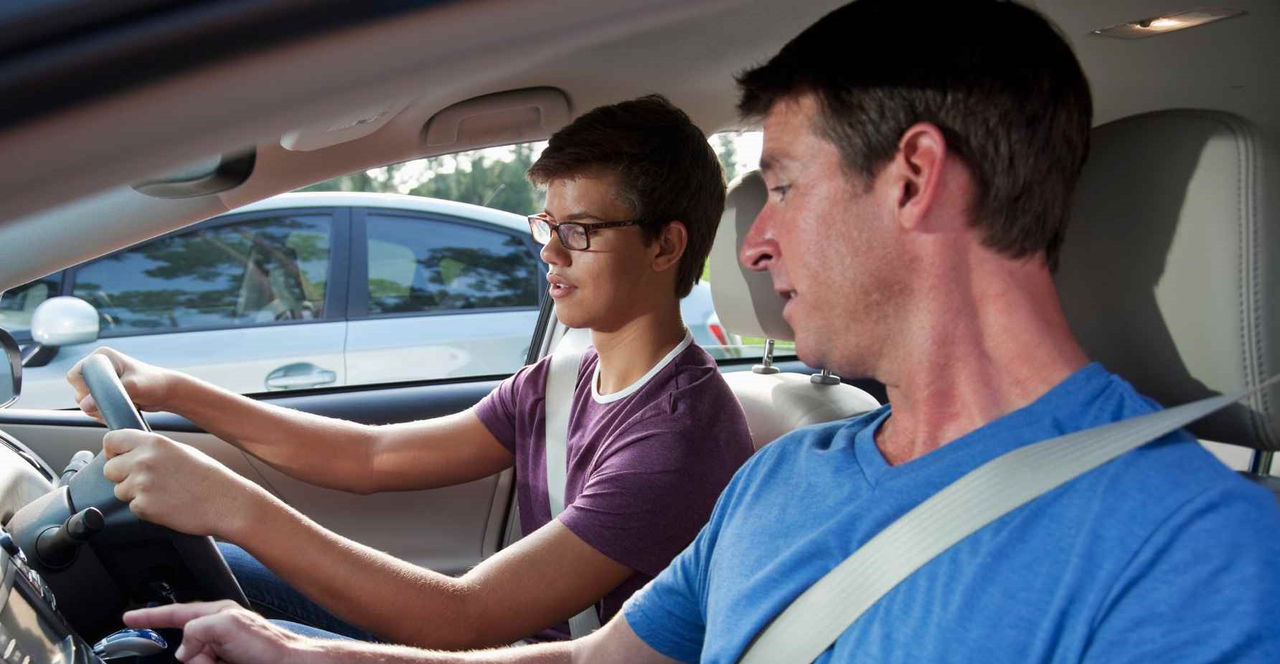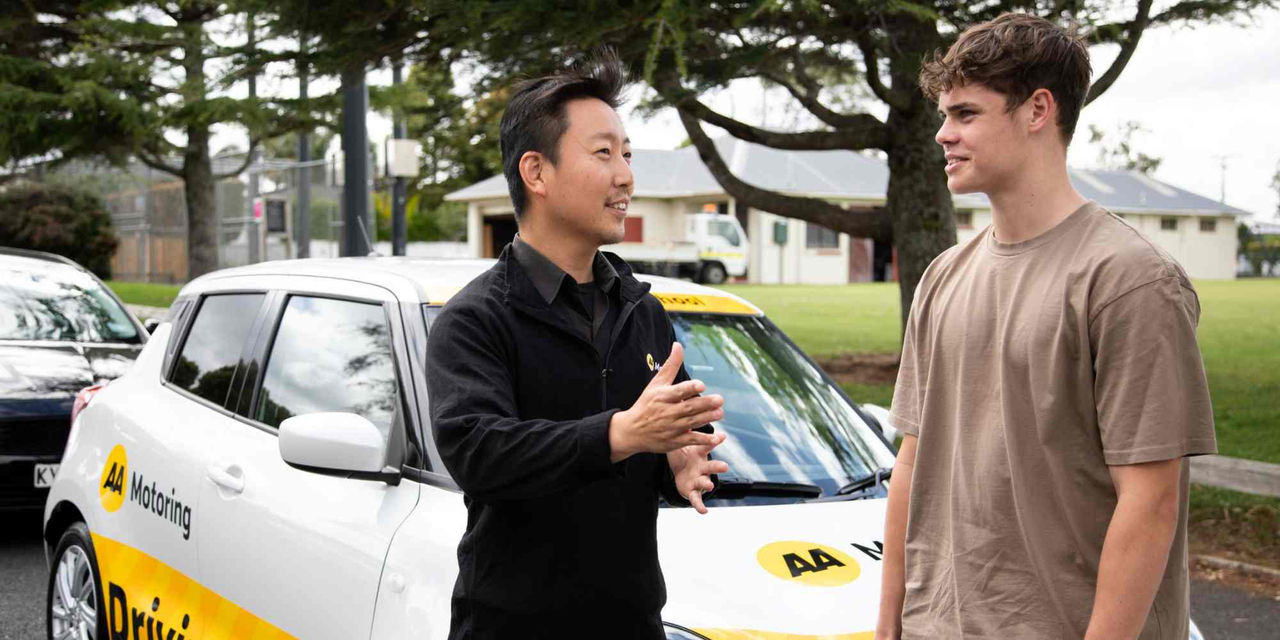If your child, other relative or friend is learning to drive with your help, you will need to be well prepared to help them on their learning journey. Please read the tips and advice below on how to teach someone to drive.
The road rules and the way we teach driving skills have probably changed quite a bit since you learned to drive. Here you’ll find helpful information and guidance to you get started on becoming a great driving practice supervisor.
Who can be a supervisor
To be a practice supervisor you must have a full licence, which you’ve held for at least two years. You must sit in the front passenger seat at all times. It also helps if you:
- Are patient and good at explaining things
- Give clear instructions
- Know the New Zealand Road Code
- Can spend a lot of time with your learner in the car
- Stay calm under pressure
- Are willing to support a carefully planned learning programme
Book yourself a refresher driving lesson with an AA instructor to ensure you’re on the right track before you start helping your learner driver.
Getting started
The AA recommends that all new learner drivers start driving with a professional driving instructor who will teach the basics and provide the right skills and attitudes right from the start.
All of our cars have dual controls which helps make sure that your son or daughter will be safe when they first start out.
Teaching someone to drive needs considerable patience, empathy, and knowledge of what is needed to prepare them not only to pass their test but to become a responsible driver. Many parents understandably approach this task with trepidation and high anxiety; you need to decide which parent is best suited to the task.
This will probably have more to do with relationships and temperament than whether Mum or Dad has the most driving experience.
Questions you should ask yourself:
- Do I get nervous or anxious when other people are driving?
- Do I have the ability to guide my son or daughter through a potentially dangerous situation on the road just by using my voice?
- Can I stay calm or will I lose my temper if they make a mistake?
Your approach and attitude
It takes special skills to teach a person to drive safely no matter how competent a driver we think we are. Therefore, consider enrolling on an AA defensive driving course for experienced drivers to iron out any bad habits you may have picked up over the years.
Children are influenced by watching their parent's behaviour, so set a good example to your learner driver by always wearing your seat belt. Drive courteously and defensively, be patient and never lose your temper. If you are an aggressive or selfish driver, the likelihood is your son or daughter will mimic your driving style.

Feedback and advice
Remember your aim is to teach your son or daughter to become a responsible driver so treat them like an adult. When coaching them, don't talk down to them or address them like a child. Avoid negative character comments such as "You're making me a nervous wreck" or "You're not listening as usual".
Praise specific progress and improvement, while offering non-judgmental, optimistic encouraging words such as "You're remembering to signal almost every time now and soon it will become second nature to you", or "Well done!".
If your learner driver makes a mistake, try to keep an even tone to your voice with your comments making them aware rather than making them feel guilty. For example, if you notice the car's speed is increasing, rather than pointing out that your teenager is breaking the law, ask them, "Do you know what the speed limit is on this road?".
Try to focus on the action required rather than the desired result. If your learner panics when approaching a traffic light or other situation, screaming, to slow down is unlikely to help - advice to "press the foot brake" might be more useful.
Equally important is to focus on the positive, e.g. "don't go too near to the parked cars" puts attention on the parked cars and increases the likelihood of the driver getting close. "Keep well towards the centre of the road and look well ahead" takes attention away from the parked cars and is more likely to have the desired effect.
Your aim is to make the time spent in the car together a happy time, so don't use instructional time as an opportunity to criticise their school report or the fact that they failed to tidy their bedroom. Be patient! Keep a positive, helpful tone and avoid sarcastic comments.
Plan to practice
Finding time to practice can sometimes be difficult. It is a good idea to plan in regular practice sessions to fit in with your routine and make sure you have given yourselves enough time for the practice session so that you don’t feel rushed.
So, think about opportunities when your learner driver can practise their driving on a trip you have already planned. Driving to school or to the shops at the weekend are good ways to practise their skills and to improve confidence.
It's essential that you both know what to expect from each other before you get in the car. It's always best to know beforehand where you're taking them and what you'll be working on in a particular lesson; so plan the lessons in advance with a list of exercises and standards that need to be achieved before moving on to the next task.
For example, "Today we're going to drive on the dual carriageway to practice driving at higher speeds, changing lanes and how to use the slip roads safely".

What is good driving practice?
It is almost always better to teach in the car that they will be taking their test in, manual or automatic.
Before you start driving, sit in the stationary car and check your learner understands and has mastered the controls, mirrors and switches, has a comfortable driving position with the seat at the right height, the steering wheel adjusted to be comfortable and being able to reach and operate the pedals correctly.
Find a place where there is no traffic, such as an unused car parking area, and practice moving off, stopping and turning. Always make sure that the before moving off that “mirror, signal, manoeuvre’ becomes a good habit. When you think you are both ready move onto a planned and familiar route with little or no traffic.
As your learner driver improves their ability to control the vehicle in easy road conditions, start to introduce more challenging, complex driving conditions to improve their observation, reactions and thinking skills.
Keep varying your practice routes and make sure you drive:
- To different places
- Longer distances
- In different weather conditions
- At busier times of the day
- iI the day and evening to introduce different lighting conditions
As a supervisor you should also be driving the car, in your mind, from the passenger seat. Look well ahead and use your experience to coach your learner driver on potential hazards and the correct action to take if you think they have not recognised it.
At the end of each practice session, spend some time reviewing what went well, what didn’t go so well and what to include in the next practice session as a result. Try and keep your feedback session relaxed.
How much practice does a learner driver need?
To become really good at something takes a lot of time and practice and learning to drive is no different. It is important for your learner driver to repeat the new actions and manoeuvres they have learned over and over again until they become second nature. However, this alone will not make them a competent safe driver.
They also need to become observant to potential hazards and be able to respond quickly and safely to unexpected hazards. Test understanding by asking your learner driver to describe out loud the hazards they observe and what actions they are taking to respond safely. This will help you too, as you then know they are seeing and reacting to what you’re seeing.
Research has shown that the more practice learner drivers get at home, the safer they will be after passing the test. It's a tough message but with motor accidents being the single biggest killer of young people between the ages of 17 and 24 getting the right start behind the wheel is essential.
When a learner driver has practiced on their learner licence for six months, it could be time to take the restricted practical test. To make sure they are ready, the learner driver will benefit from lessons with a professional driver to make sure they have the right skills and practice for the test.


